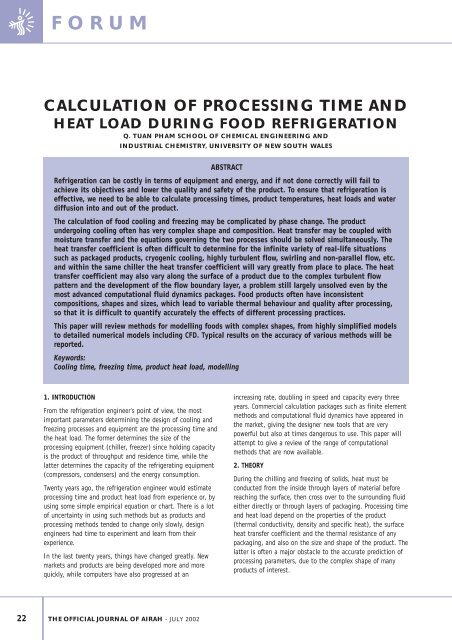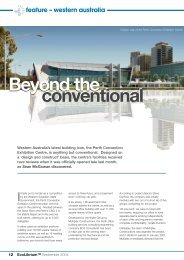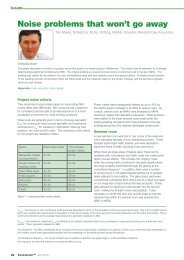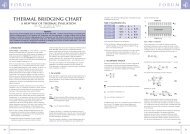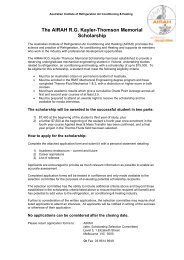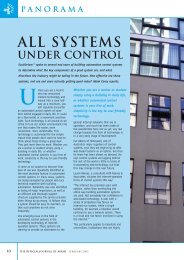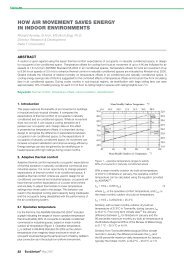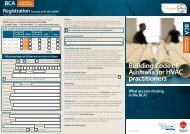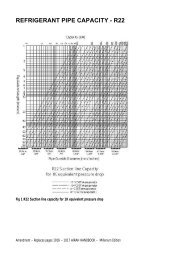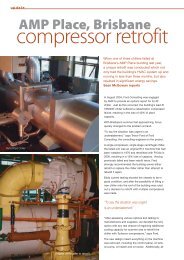calculation of processing time and heat load during food refrigeration
calculation of processing time and heat load during food refrigeration
calculation of processing time and heat load during food refrigeration
You also want an ePaper? Increase the reach of your titles
YUMPU automatically turns print PDFs into web optimized ePapers that Google loves.
22<br />
FORUM<br />
CALCULATION OF PROCESSING TIME AND<br />
HEAT LOAD DURING FOOD REFRIGERATION<br />
Q. Tuan Pham School <strong>of</strong> Chemical Engineering <strong>and</strong><br />
1. INTRODUCTION<br />
Industrial Chemistry, University <strong>of</strong> New South Wales<br />
ABSTRACT<br />
Refrigeration can be costly in terms <strong>of</strong> equipment <strong>and</strong> energy, <strong>and</strong> if not done correctly will fail to<br />
achieve its objectives <strong>and</strong> lower the quality <strong>and</strong> safety <strong>of</strong> the product. To ensure that <strong>refrigeration</strong> is<br />
effective, we need to be able to calculate <strong>processing</strong> <strong>time</strong>s, product temperatures, <strong>heat</strong> <strong>load</strong>s <strong>and</strong> water<br />
diffusion into <strong>and</strong> out <strong>of</strong> the product.<br />
The <strong>calculation</strong> <strong>of</strong> <strong>food</strong> cooling <strong>and</strong> freezing may be complicated by phase change. The product<br />
undergoing cooling <strong>of</strong>ten has very complex shape <strong>and</strong> composition. Heat transfer may be coupled with<br />
moisture transfer <strong>and</strong> the equations governing the two processes should be solved simultaneously. The<br />
<strong>heat</strong> transfer coefficient is <strong>of</strong>ten difficult to determine for the infinite variety <strong>of</strong> real-life situations<br />
such as packaged products, cryogenic cooling, highly turbulent flow, swirling <strong>and</strong> non-parallel flow, etc.<br />
<strong>and</strong> within the same chiller the <strong>heat</strong> transfer coefficient will vary greatly from place to place. The <strong>heat</strong><br />
transfer coefficient may also vary along the surface <strong>of</strong> a product due to the complex turbulent flow<br />
pattern <strong>and</strong> the development <strong>of</strong> the flow boundary layer, a problem still largely unsolved even by the<br />
most advanced computational fluid dynamics packages. Food products <strong>of</strong>ten have inconsistent<br />
compositions, shapes <strong>and</strong> sizes, which lead to variable thermal behaviour <strong>and</strong> quality after <strong>processing</strong>,<br />
so that it is difficult to quantify accurately the effects <strong>of</strong> different <strong>processing</strong> practices.<br />
This paper will review methods for modelling <strong>food</strong>s with complex shapes, from highly simplified models<br />
to detailed numerical models including CFD. Typical results on the accuracy <strong>of</strong> various methods will be<br />
reported.<br />
Keywords:<br />
Cooling <strong>time</strong>, freezing <strong>time</strong>, product <strong>heat</strong> <strong>load</strong>, modelling<br />
From the <strong>refrigeration</strong> engineer’s point <strong>of</strong> view, the most<br />
important parameters determining the design <strong>of</strong> cooling <strong>and</strong><br />
freezing processes <strong>and</strong> equipment are the <strong>processing</strong> <strong>time</strong> <strong>and</strong><br />
the <strong>heat</strong> <strong>load</strong>. The former determines the size <strong>of</strong> the<br />
<strong>processing</strong> equipment (chiller, freezer) since holding capacity<br />
is the product <strong>of</strong> throughput <strong>and</strong> residence <strong>time</strong>, while the<br />
latter determines the capacity <strong>of</strong> the refrigerating equipment<br />
(compressors, condensers) <strong>and</strong> the energy consumption.<br />
Twenty years ago, the <strong>refrigeration</strong> engineer would estimate<br />
<strong>processing</strong> <strong>time</strong> <strong>and</strong> product <strong>heat</strong> <strong>load</strong> from experience or, by<br />
using some simple empirical equation or chart. There is a lot<br />
<strong>of</strong> uncertainty in using such methods but as products <strong>and</strong><br />
<strong>processing</strong> methods tended to change only slowly, design<br />
engineers had <strong>time</strong> to experiment <strong>and</strong> learn from their<br />
experience.<br />
In the last twenty years, things have changed greatly. New<br />
markets <strong>and</strong> products are being developed more <strong>and</strong> more<br />
quickly, while computers have also progressed at an<br />
THE OFFICIAL JOURNAL OF AIRAH - July 2002<br />
increasing rate, doubling in speed <strong>and</strong> capacity every three<br />
years. Commercial <strong>calculation</strong> packages such as finite element<br />
methods <strong>and</strong> computational fluid dynamics have appeared in<br />
the market, giving the designer new tools that are very<br />
powerful but also at <strong>time</strong>s dangerous to use. This paper will<br />
attempt to give a review <strong>of</strong> the range <strong>of</strong> computational<br />
methods that are now available.<br />
2. THEORY<br />
During the chilling <strong>and</strong> freezing <strong>of</strong> solids, <strong>heat</strong> must be<br />
conducted from the inside through layers <strong>of</strong> material before<br />
reaching the surface, then cross over to the surrounding fluid<br />
either directly or through layers <strong>of</strong> packaging. Processing <strong>time</strong><br />
<strong>and</strong> <strong>heat</strong> <strong>load</strong> depend on the properties <strong>of</strong> the product<br />
(thermal conductivity, density <strong>and</strong> specific <strong>heat</strong>), the surface<br />
<strong>heat</strong> transfer coefficient <strong>and</strong> the thermal resistance <strong>of</strong> any<br />
packaging, <strong>and</strong> also on the size <strong>and</strong> shape <strong>of</strong> the product. The<br />
latter is <strong>of</strong>ten a major obstacle to the accurate prediction <strong>of</strong><br />
<strong>processing</strong> parameters, due to the complex shape <strong>of</strong> many<br />
products <strong>of</strong> interest.
The <strong>processing</strong> <strong>time</strong> is usually defined as the <strong>time</strong> for the<br />
thermal centre <strong>of</strong> the product to reach a certain temperature.<br />
In a complex geometry, it depends on what happens in the<br />
thickest part <strong>of</strong> the object, for example the rump <strong>of</strong> a carcass.<br />
The <strong>heat</strong> <strong>load</strong> varies greatly <strong>during</strong> <strong>processing</strong>, being highest<br />
at the start, <strong>and</strong> this peak <strong>heat</strong> <strong>load</strong>, which may determine<br />
<strong>refrigeration</strong> requirements, <strong>of</strong>ten depends on what happens in<br />
the thinnest parts (biggest surface area per unit volume).<br />
Only in objects <strong>of</strong> simple, regular shapes (spheres, long<br />
cylinders, large slabs) will both be determined by the same<br />
dimension.<br />
When the internal resistance to <strong>heat</strong> transfer is negligible<br />
compared to the surface resistance, the whole object will be<br />
at uniform temperature <strong>and</strong> the <strong>calculation</strong> <strong>of</strong> <strong>processing</strong> <strong>time</strong><br />
<strong>and</strong> <strong>heat</strong> <strong>load</strong> becomes trivial (temperature <strong>and</strong> <strong>heat</strong> <strong>load</strong><br />
falls exponentially with <strong>time</strong>). In the more general case the<br />
Biot number, Bi, measures the ratio <strong>of</strong> internal to external<br />
resistance:<br />
Bi = hR / k (1)<br />
where h is the surface <strong>heat</strong> transfer coefficient (including the<br />
effect <strong>of</strong> any packaging, radiation <strong>and</strong> evaporative cooling), R<br />
the smallest half-dimension <strong>and</strong> k the thermal conductivity <strong>of</strong><br />
the product. The Biot number is <strong>of</strong> fundamental importance to<br />
any study <strong>of</strong> <strong>heat</strong> transfer to solid objects. Internal resistance<br />
can be neglected if Bi
FORUM<br />
average <strong>heat</strong> <strong>load</strong> Q0-0.7 between <strong>time</strong> 0 <strong>and</strong> <strong>time</strong> f. log10<br />
(jm/0.7), at which the residual mean temperature difference<br />
has fallen to 70% <strong>of</strong> its initial value, is<br />
Q0-0.7 = 0.3 mc (Ti - Ta) / [f. log10 (jm/0.7)] (6)<br />
Freezing <strong>time</strong><br />
The freezing <strong>of</strong> a <strong>food</strong> can be divided into three distinct<br />
periods:<br />
1. A precooling period, where cooling takes place without<br />
phase change.<br />
2. A phase change period, which starts when the surface<br />
reaches the freezing point Tf <strong>and</strong> ice forms at the surface.<br />
The freezing front gradually advances into the product,<br />
until it reaches the thermal centre <strong>and</strong> the whole <strong>food</strong> can<br />
be considered frozen.<br />
3. A postcooling period, <strong>during</strong> which the whole <strong>food</strong><br />
continues to cool below Tf.<br />
Plank [12,13] presented an analytical solution for the phase<br />
change period only. For many years, Plank’s equation was the<br />
only one available <strong>and</strong> it is still taught in many textbooks.<br />
However, it can lead to large errors (typically 30%). There is<br />
no analytical solution for <strong>food</strong> freezing that includes all three<br />
periods. Furthermore <strong>food</strong> freezing is more complicated than<br />
the freezing <strong>of</strong> pure water, because the water in the <strong>food</strong><br />
does not freeze instantaneously but does so over a range <strong>of</strong><br />
temperature. To predict freezing <strong>time</strong> for a simple shape,<br />
many empirical equations have been presented in the last<br />
twenty five years. A fairly simple equation which is<br />
nevertheless quite accurate ( + –<br />
10%) is that by the author<br />
(Pham [14]):<br />
R H1 H2 Bi<br />
tf =<br />
+ 1+<br />
EFreezeh T1 T2 2<br />
where Bi = hR/kf, EFreeze is the equivalent <strong>heat</strong> transfer<br />
dimensionality (EHTD) shape factor for freezing (1 for slab, 2<br />
for infinite cylinders, 3 for spheres), H1 <strong>and</strong> T1 are the<br />
volumetric enthalpy change <strong>and</strong> temperature difference<br />
respectively for the precooling period, <strong>and</strong> H2 <strong>and</strong> T2 those<br />
for the combined freezing-postcooling period.<br />
As in cooling, the freezing <strong>of</strong> an irregular shape can be<br />
approximated by that <strong>of</strong> an equivalent regular shape; for<br />
example, an ellipsoid can be approximated by an equivalent<br />
sphere. The technique has also been frequently used on<br />
specific products such as lamb legs.<br />
Another approach for complex shapes is to first calculate the<br />
freezing <strong>time</strong> for a slab then divide it by the shape factor<br />
EFreeze, which is available for many shapes (Hossain et al. [15,<br />
16], (1992a) Clel<strong>and</strong> et al. [17,18], McNabb et al. [19,20])<br />
Clel<strong>and</strong> et al., 1987b,c; Hossain et al., 1992a,b.<br />
24 THE OFFICIAL JOURNAL OF AIRAH - July 2002<br />
(7)<br />
Freezing <strong>heat</strong> <strong>load</strong><br />
A simple method for calculating freezing <strong>heat</strong> <strong>load</strong>s was<br />
proposed by Lovatt et al. [21,22]. It is based on how the<br />
freezing front moves towards the thermal centre <strong>and</strong> involves<br />
an empirical shape factor N, which may be different from the<br />
shape factor E for freezing <strong>time</strong> (because the peak initial <strong>heat</strong><br />
<strong>load</strong> depends on what happens in the thinnest parts <strong>of</strong> the<br />
product while freezing <strong>time</strong> depends on what happens in the<br />
thickest parts).<br />
Calculating Product Heat Load in an Industrial Cooler or<br />
Freezer<br />
The methods described in this section enable the <strong>calculation</strong><br />
<strong>of</strong> <strong>heat</strong> <strong>load</strong> from a single item <strong>of</strong> product. However, in<br />
industry normally many items will be processed at one <strong>time</strong>,<br />
<strong>and</strong> it is important to take into account the operational<br />
characteristics <strong>of</strong> the process. For a strict batch operation,<br />
when the cooler is filled with product before <strong>refrigeration</strong> is<br />
turned on, the <strong>refrigeration</strong> must be able to cope with the<br />
peak <strong>heat</strong> <strong>load</strong> under the starting condition. For a continuous<br />
operation, the <strong>heat</strong> <strong>load</strong> is constant <strong>and</strong> can be calculated<br />
from the mean temperatures <strong>of</strong> the entering <strong>and</strong> leaving<br />
products <strong>and</strong> the throughput. Many operations in the <strong>food</strong><br />
industry operate in an intermediate mode; for example, a<br />
chiller or freezer may be <strong>load</strong>ed/un<strong>load</strong>ed continuously <strong>during</strong><br />
day<strong>time</strong> <strong>and</strong> then continue to cool batchwise <strong>during</strong> the<br />
night. At any <strong>time</strong> t, the product in the cooler will have<br />
residence <strong>time</strong>s ranging from 0 to tmax <strong>and</strong> hence varying <strong>heat</strong><br />
<strong>load</strong>s. In such situations, the total <strong>heat</strong> <strong>load</strong> at <strong>time</strong> t is<br />
made up <strong>of</strong> the <strong>heat</strong> <strong>load</strong> from product <strong>load</strong>ed at all <strong>time</strong>s<br />
between t - tmax <strong>and</strong> t. The <strong>time</strong> from t - tmax to t can be<br />
divided into a number <strong>of</strong> intervals, the <strong>heat</strong> <strong>load</strong> from product<br />
<strong>load</strong>ed in each interval calculated <strong>and</strong> added together.<br />
4. NUMERICAL (DISCRETIZATION) METHODS<br />
In numerical discretization methods (finite differences, finite<br />
elements, finite volume), the product is divided into small<br />
control volumes or elements. The <strong>heat</strong> conduction equation is<br />
written for each <strong>of</strong> these control volumes/elements, giving a<br />
set <strong>of</strong> hundreds, thous<strong>and</strong>s or some<strong>time</strong>s millions <strong>of</strong><br />
equations. These equations are then solved together to<br />
calculate the change with <strong>time</strong> <strong>of</strong> the temperature in each<br />
location.<br />
Finite differences (FD) was the earliest such method. The<br />
product is represented by a regular grid <strong>and</strong> the equations for<br />
<strong>heat</strong> flow between the “nodes” (grid points) are written out<br />
<strong>and</strong> solved by computers. Nowadays, the solution <strong>of</strong> a finite<br />
difference problem on a computer is very fast, <strong>of</strong> the order <strong>of</strong><br />
a few seconds or less. The finite difference equations can be<br />
set up <strong>and</strong> solved by any mathematically competent<br />
engineering graduate. However, this method is practical only<br />
for objects that have a reasonably regular shape, such as a<br />
rectangular box or a finite cylinder.
Finite Elements (FE) is preferred to finite differences for<br />
modelling objects with complex, irregular shapes. A grid is<br />
still used but it can be irregular, consisting <strong>of</strong> triangles,<br />
distorted rectangles or volumes <strong>of</strong> various shapes. The grid<br />
can be in two or three dimensions. Finite elements models<br />
take more <strong>time</strong> to solve than finite difference models due to<br />
the larger b<strong>and</strong>with <strong>of</strong> the matrix equations that need to be<br />
solved. On a modern PC, a two-dimensional FE model may<br />
take several minutes to solve while a three-dimensional FE<br />
model may take an hour or more. Also, it is more difficult to<br />
set up the model, usually requiring special graphical s<strong>of</strong>tware.<br />
However this is not due to the nature <strong>of</strong> the model but to the<br />
complex shape that such models are applied to. FD models are<br />
easier to set up but that is only because the real shape is<br />
usually approximated by a more regular shape.<br />
The theory behind finite elements is mathematically abstract,<br />
<strong>and</strong> nowadays the method <strong>of</strong> finite volumes (FV), which<br />
combines the flexibility <strong>of</strong> finite elements with the<br />
conceptual simplicity <strong>of</strong> finite differences, has become widely<br />
popular. The object is divided into small control volumes <strong>of</strong><br />
arbitrary shape (as in finite elements), <strong>and</strong> the equations <strong>of</strong><br />
conservation for <strong>heat</strong>, mass <strong>and</strong> momentum are written for<br />
each control volumes. Computational effort is similar for FV<br />
<strong>and</strong> FE. FV is widely used in computational fluid dynamics<br />
(CFD) models.<br />
5. CFD METHOD<br />
One <strong>of</strong> the big uncertainties in calculating process <strong>time</strong> <strong>and</strong><br />
<strong>heat</strong> <strong>load</strong> is the <strong>heat</strong> transfer coefficient at the surface <strong>of</strong> the<br />
product. Often the air is highly turbulent, the shape is<br />
complex giving rise to boundary layer variation <strong>and</strong> eddies,<br />
which make the <strong>heat</strong> transfer coefficient vary from place to<br />
place <strong>and</strong> become highly unpredictable. In other cases such<br />
as cartoned product, the presence <strong>of</strong> air gaps with irregular<br />
shapes containing natural convection cells make the effective<br />
<strong>heat</strong> transfer coefficient difficult to predict. In these cases<br />
the technologist must <strong>of</strong>ten carry out a large number <strong>of</strong><br />
experiments, or make gross approximations based on<br />
experience.<br />
Computational Fluid Dynamics <strong>of</strong>fer the promise <strong>of</strong><br />
eliminating these uncertainties, by calculating the flow<br />
pattern <strong>and</strong> <strong>heat</strong> transfer at the product surface from first<br />
principles, using the basic equations <strong>of</strong> <strong>heat</strong>, mass <strong>and</strong><br />
momentum transfer. This has become possible owing to the<br />
huge computing power <strong>of</strong> modern computers.<br />
For the case <strong>of</strong> laminar flow, CFD has indeed lived up to its<br />
promise. However, most industrial situations involve turbulent<br />
flow, for which CFD is still unable to entirely deliver the<br />
goods. This is because turbulent flow involves stochastic<br />
variations in the flow <strong>and</strong> temperature pattern, which must be<br />
averaged out, <strong>and</strong> <strong>during</strong> this averaging process, empirical<br />
equations <strong>and</strong> coefficients must be introduced <strong>and</strong> the<br />
equations lose their fundamentality. They must incorporate<br />
turbulence models which are still conceptually suspect <strong>and</strong><br />
involve a large number <strong>of</strong> empirical coefficients. The empirical<br />
coefficients are specific to each flow situation <strong>and</strong> if they are<br />
used beyond these (i.e. in almost every new situation<br />
practice), accuracy is no longer guaranteed.<br />
To illustrate these points, Pham <strong>and</strong> Nguyen’s [23] CFD<br />
simulation results for <strong>heat</strong> transfer coefficients <strong>during</strong> beef<br />
chilling is presented in Figure 1, using the st<strong>and</strong>ard kmodel<br />
<strong>and</strong> the RNG (ReNormalisation Group Theory) k- model<br />
respectively. Both <strong>of</strong> these are empirical models with several<br />
empirical coefficients. It can be seen that different <strong>heat</strong><br />
transfer coefficients are predicted by the two models.<br />
Another obstacle against the widespread use <strong>of</strong> CFD models is<br />
the large amount <strong>of</strong> developmental <strong>time</strong> <strong>and</strong> computation<br />
effort involved. It took about three months <strong>of</strong> an experienced<br />
user’s <strong>time</strong> to build the finite volume <strong>of</strong> a beef side model,<br />
<strong>and</strong> simulating a 20-hour run took a week on a 300-MHz<br />
personal computer, with frequent intervention from the user<br />
to optimise relaxation factors etc. (<strong>and</strong> that’s ignoring mass<br />
transfer).<br />
Nevertheless, computer power continues to increase quickly,<br />
<strong>and</strong> one can expect that more fundamental turbulence models<br />
(such as the large eddy simulation model) will eventually<br />
become practicable for the <strong>food</strong> industry <strong>and</strong> yield reliable<br />
results.<br />
Pseudo-steady state CFD simulation<br />
FORUM<br />
In view <strong>of</strong> the large computing <strong>time</strong> required to simulate a<br />
transient problem, a good compromise is to use CFD to<br />
calculate the <strong>heat</strong> transfer coefficient for a steady state<br />
situation, which is much faster <strong>and</strong> takes minutes instead <strong>of</strong><br />
days. Since the htc varies only slowly with <strong>time</strong>, it can be<br />
assumed to remain the same for a significant fraction <strong>of</strong> the<br />
process <strong>time</strong>. Thus, changes in temperature can be calculated<br />
using a conduction model (FD, FE or FV) for the inside <strong>of</strong> the<br />
product only, which is again much faster than a full transient<br />
CFD <strong>calculation</strong>. Such a <strong>calculation</strong> gave good results for beef<br />
chilling (Pham <strong>and</strong> Nguyen [23])<br />
THE OFFICIAL JOURNAL OF AIRAH - July 2002<br />
3<br />
3<br />
25
FORUM<br />
Figure 1. Heat transfur coefficient predicted using the<br />
st<strong>and</strong>ard k- model (dotted curves) <strong>and</strong> the RNG kmodel.<br />
3<br />
6. ACCURACY OF COOLING AND FREEZING PREDICTION<br />
METHODS<br />
In view <strong>of</strong> the large range <strong>of</strong> <strong>calculation</strong> methods available it<br />
would be useful to compare them against each other <strong>and</strong><br />
against empirical data, where available. This will help the<br />
<strong>refrigeration</strong> engineer <strong>and</strong> <strong>food</strong> engineer decide which to use<br />
should the need arise.<br />
Errors in predicting cooling <strong>time</strong><br />
Prediction errors can be due to the following sources:<br />
• errors inherent in the <strong>calculation</strong> method (for example, by<br />
approximating the cooling curve by the f-j exponential)<br />
• errors in the product’s thermal properties (thermal<br />
diffusivity)<br />
• errors in the <strong>heat</strong> transfer coefficient-effect <strong>of</strong><br />
turbulence, radiation, evaporation, wrapping etc.<br />
• errors in predicting the effect <strong>of</strong> complex shape<br />
The first source <strong>of</strong> errors can be eliminated by using a strict<br />
analytical or numerical method, however the other sources <strong>of</strong><br />
errors cannot be entirely eliminated. Surprisingly little data is<br />
available on the extent <strong>of</strong> these errors in practice. However,<br />
we can expect that they will be <strong>of</strong> the same order as those<br />
incurred <strong>during</strong> freezing <strong>calculation</strong>s, for which data are<br />
available, as will be seen below.<br />
Errors in predicting freezing <strong>time</strong><br />
Clel<strong>and</strong> [24] did some careful analysis <strong>of</strong> the most well known<br />
freezing <strong>time</strong> prediction methods (Table 1). It can be seen<br />
that the most accurate methods, such as that <strong>of</strong> Pham<br />
presented above, can predict freezing <strong>time</strong> to about +–<br />
10%.<br />
There is also quite good agreement between simplified<br />
formulas <strong>and</strong> numerical methods such as finite differences.<br />
26 THE OFFICIAL JOURNAL OF AIRAH - July 2002<br />
3<br />
It must be noted that these error values apply to experiments<br />
carried out in the laboratory under carefully monitored<br />
conditions, with well known test materials, so that the errors<br />
due to <strong>heat</strong> transfer coefficients, product shape <strong>and</strong> material<br />
properties are minimal. In industry, larger errors can be<br />
expected, although with some expertise, errors <strong>of</strong> perhaps no<br />
more than +– 15% can be achieved.<br />
Errors in predicting cooling <strong>and</strong> freezing <strong>heat</strong> <strong>load</strong><br />
The author <strong>and</strong> his associates at MIRINZ, Massey University<br />
(NZ) <strong>and</strong> the University <strong>of</strong> New South Wales seem to have<br />
been the only group to have gathered reasonably accurate<br />
<strong>heat</strong> <strong>load</strong> data <strong>during</strong> cooling <strong>and</strong> freezing. These data have<br />
been obtained using a flow calorimeter technique [25] (Figure<br />
2). The hot product, for example a carton <strong>of</strong> meat or a beef<br />
side, is put in a wind tunnel. A thermopile (a sensitive<br />
differential temperature sensor) is made by having an array <strong>of</strong><br />
thermocouples distributed over the inlet flow area <strong>and</strong><br />
another over the outlet flow area. The thermocouple pairs are<br />
connected in series, thus multiplying the thermoelectric<br />
signal. For example, with 20 thermocouple pairs, a voltage<br />
signal <strong>of</strong> about 8 µV is obtained for every 0.01ºC temperature<br />
rise in the air, which can be easily measured with a digital<br />
voltmeter accurate to 1µV. There are some errors (normally<br />
less than 5%) introduced by <strong>heat</strong> loss through the tunnel<br />
walls <strong>and</strong> other unknown causes. The tunnel was calibrated<br />
with an electric <strong>heat</strong>er to correct for these errors.<br />
A typical <strong>heat</strong> <strong>load</strong> curve for beef chilling (Davey <strong>and</strong> Pham<br />
[8]) is shown in Figure 3. Davey <strong>and</strong> Pham [26] did a<br />
comparison <strong>of</strong> predicted <strong>and</strong> measured <strong>heat</strong> <strong>load</strong> (averaged<br />
over the first two hours <strong>of</strong> chilling) for 55 beef chilling tests<br />
(Table 2). It can be seen that the predictions for both a finite<br />
differences model <strong>and</strong> a 2-D finite element models are quite<br />
acceptable, although there is a definite improvement with the<br />
FE model (5.6% average error in <strong>heat</strong> <strong>load</strong> for FE vs 12.6% for<br />
FD).<br />
7. CONCLUSIONS AND FUTURE RESEARCH NEEDS<br />
A wide range <strong>of</strong> methods for predicting cooling/freezing <strong>time</strong>s<br />
<strong>and</strong> <strong>heat</strong> <strong>load</strong>s, from simple approximate equations to<br />
complex CFD models. Although sophisticated, theory-based<br />
methods are becoming more practical with the fast progress<br />
in computer hardware <strong>and</strong> s<strong>of</strong>tware, simplified methods can<br />
still be useful in many cases. CFD is still basically a research<br />
tool in view <strong>of</strong> the major effort involved in setting up the<br />
simulation, large computing <strong>time</strong> <strong>and</strong> continuing difficulty in<br />
dealing with complex turbulent flow situations. For the<br />
majority <strong>of</strong> practical cases, a good practical compromise is<br />
the use <strong>of</strong> finite differences or finite elements code for<br />
conduction inside the product, combined with <strong>heat</strong> transfer<br />
coefficients obtained from empirical equations or CFD<br />
simulations.
Future research needs include<br />
• more research on physical properties <strong>of</strong> <strong>food</strong>s<br />
• better turbulence models for convection cooling, although<br />
this may be some <strong>time</strong> in coming. While waiting for this,<br />
• more <strong>heat</strong> transfer convection data for a variety <strong>of</strong><br />
situations, including:<br />
Table 1. Comparison <strong>of</strong> simplified<br />
freezing <strong>time</strong> prediction methods with<br />
experiments <strong>and</strong> finite difference<br />
<strong>calculation</strong>s.<br />
Figure 2. Wind tunnel cum flow calorimeter<br />
designed by Davey <strong>and</strong> Pham [25]<br />
Table 2. Comparison <strong>of</strong> FD <strong>and</strong> FE model against<br />
experimental data for 55 tests.<br />
FORUM<br />
• packages with air voids when there may be convection <strong>and</strong><br />
radiation within voids, <strong>and</strong> partial ventilation through<br />
packages.<br />
• <strong>heat</strong> transfer in porous <strong>food</strong>s where there are interactions<br />
between heart <strong>and</strong> nass transfer<br />
Method Mean SD Range Correl.<br />
(%) (%) (%)<br />
Finite Differences 0.1 7.6 -11 to 12 –<br />
Clel<strong>and</strong> & Earle (1984b) -0.2 6.3 -10 to 10 0.728<br />
Hung & Thompson (1983)a -1.7 8.7 -8 to 21 0.373<br />
Eqn A2 <strong>of</strong> Clel<strong>and</strong> et al (1987a) -0.9 6.7 -13 to 9 0.723<br />
de Michelis & Cavclo (1983) -1.7 11.4 -17 to 18 0.858<br />
Pham (1984) 0.4 7.1 -11 to 9 0.787<br />
Pham (1986a) 1.1 7.3 -11 to 12 0.772<br />
Range = range enclosing 90% <strong>of</strong> the percentage differences.<br />
Correl. = corrrelation coefficient with finite differences.<br />
Figure 3. Comparison <strong>of</strong> <strong>heat</strong> <strong>load</strong> prediction by FE, FD<br />
<strong>and</strong> experimental results for a beef chilling experiment.<br />
FD Model FE Model<br />
Representation <strong>of</strong> beef side 7 simple- 13 crossshaped<br />
regions sections<br />
Average % error in <strong>heat</strong><br />
removed <strong>during</strong> first 2 hours -12.6 % -5.6 %<br />
Average % error in weight loss<br />
after 20 hours <strong>of</strong> chilling -1.25% 2.32 %<br />
Time to simulate 20 hour process<br />
on Pentium 166 Mhz Computer < 1 min 4-5 hours<br />
THE OFFICIAL JOURNAL OF AIRAH - July 2002<br />
27
FORUM<br />
REFERENCES<br />
[1] Carslaw, H.S., Jaeger, J.C. Conduction <strong>of</strong> Heat in Solids, 2nd edn; Oxford,<br />
Clarendon Press, 1959.<br />
[2] Holman, J.P., Heat Transfer, 7th edn; New York, MacGraw-Hill, 1992.<br />
[3] Pflug, I.J., Blaisdell, J.L., Kopelman, I.J. Developing temperature-<strong>time</strong> curves<br />
for objects that can be approximated by a sphere, infinite plate or infinite<br />
cylinder. ASHRAE Transactions; 1965; 71; 238-48.<br />
[4] Ramaswamy, H.S., Lo, K.V., Tung, M.A. Simplified equations for transient<br />
temperatures in conductive <strong>food</strong>s with convective <strong>heat</strong> transfer at surface. Journal<br />
<strong>of</strong> Food Science; 1982; 47; 2042-2047.<br />
[5] Lacroix, C., Castaigne, F. Simple method for freezing <strong>time</strong> <strong>calculation</strong>s for<br />
infinite flat slabs, infinite cylinders <strong>and</strong> spheres. Canadian Institute <strong>of</strong> Food<br />
Science <strong>and</strong> Technology Journal; 1987; 20(4); 252-259.<br />
[6] Earle R.L., Fleming, A.K. Cooling <strong>and</strong> freezing <strong>of</strong> lamb <strong>and</strong> mutton carcasses.<br />
Food Technology; 1967; 21; 79-84.<br />
[7] Bailey C., Cox, R.P. The chilling <strong>of</strong> beef carcasses. Proceeding <strong>of</strong> the Institute<br />
<strong>of</strong> Refrigeration; 1976; 72; 76-90.<br />
[8] Davey, L.M., Pham, Q.T. Predicting the dynamic product <strong>heat</strong> <strong>load</strong> <strong>and</strong> weight<br />
loss <strong>during</strong> beef chilling using a multi-region finite difference approach.<br />
International Journal <strong>of</strong> Refrigeration; 1997; 20; 470-482.<br />
[9] Lin, Z., Clel<strong>and</strong>, A.C., Sellarach, G.F., Clel<strong>and</strong>, D.J. A simple method for<br />
prediction <strong>of</strong> chilling <strong>time</strong>s for objects <strong>of</strong> two-dimensional irregular shape.<br />
International Journal <strong>of</strong> Refrigeration; 1996; 19; 95-106.<br />
[10] Lin, Z., Clel<strong>and</strong>, A.C., Sellarach, G.F., Clel<strong>and</strong>, D.J. A simple method for<br />
prediction <strong>of</strong> chilling <strong>time</strong>s: Extension to three-dimensional irregular shapes.<br />
International Journal <strong>of</strong> Refrigeration; 1996; 19; 107-114. Erratum, International<br />
Journal <strong>of</strong> Refrigeration; 2000; 23; 168.<br />
[11] Lin, Z., Clel<strong>and</strong>, A.C., Sellarach, G.F., Clel<strong>and</strong>, D.J. Prediction <strong>of</strong> chilling<br />
<strong>time</strong>s for objects <strong>of</strong> regular multi-dimensional shapes using a general geometric<br />
factor. In Refrigeration Science <strong>and</strong> Technology 1993-3. International Institute <strong>of</strong><br />
Refrigeration, Paris; 1993; 259-267.<br />
[12] Plank, R. Die Gefrierdauer von Eisblocken. Zeitschrift fur die gesamte Kalte<br />
Industrie; 1913; 20(6); 109-114.<br />
[13] Plank, R. Beitrage zur Berechnung und Bewertung der Gefriergeschwindigkeit<br />
von Lebensmitteln. Zeitschrift fur die gesamte Kalte Industrie; 1941; 3(10); 1-16.<br />
[14] Pham, Q.T. Simplified equation for predicting the freezing <strong>time</strong> <strong>of</strong><br />
<strong>food</strong>stuffs. Journal <strong>of</strong> Food Technology; 1986; 21; 209-219.<br />
[15] Hossain, Md.M., Clel<strong>and</strong>, D.J., Clel<strong>and</strong>, A.C. Prediction <strong>of</strong> freezing <strong>and</strong><br />
thawing <strong>time</strong>s for <strong>food</strong>s <strong>of</strong> regular multidimensional shape by using an<br />
analytically derived geometric factor. International Journal <strong>of</strong> Refrigeration; 1992;<br />
15(4); 227-234.<br />
[16] Hossain, M.M., Clel<strong>and</strong>, D.J., Clel<strong>and</strong>, A.C. Prediction <strong>of</strong> freezing <strong>and</strong><br />
thawing <strong>time</strong>s for <strong>food</strong>s <strong>of</strong> two-dimensional irregular shape by using a semianalytical<br />
geometric factor. International Journal <strong>of</strong> Refrigeration; 1992; 15(4);<br />
235-240.<br />
[17] Clel<strong>and</strong> D.J., Clel<strong>and</strong> A.C., Earle R.L. Prediction <strong>of</strong> freezing <strong>and</strong> thawing<br />
<strong>time</strong>s for multidimensional shapes by simple formulae. Part : Regular shapes.<br />
International Journal <strong>of</strong> Refrigeration; 1987; 10; 156-164.<br />
[18] Clel<strong>and</strong> D.J., Clel<strong>and</strong> A.C., Earle R.L. Prediction <strong>of</strong> freezing & thawing <strong>time</strong>s<br />
for multidimensional shapes by simple formulae. Part 2: Irregular shapes.<br />
International Journal <strong>of</strong> Refrigeration; 1987; 10; 234-240.<br />
[19] McNabb, A, Wake, G.C., Hossain, Md.M., Lambourne, R.D. Transition <strong>time</strong>s<br />
28 THE OFFICIAL JOURNAL OF AIRAH - July 2002<br />
between steady states for <strong>heat</strong> conduction, Part I: General theory <strong>and</strong> some exact<br />
results. Occasional Publications in Mathematics & Statistics No.20; Massey<br />
University; 1990.<br />
[20] McNabb, A, Wake, G.C., Hossain, Md.M., Lambourne, R.D. Transition <strong>time</strong>s<br />
between steady states for <strong>heat</strong> conduction, Part II: Approximate solutions <strong>and</strong><br />
examples. Massey University, Occasional Publications in Mathematics & Statistics<br />
No.21. Massey University; 1990.<br />
[21] Lovatt, S.J., Pham, Q.T., Loeffen, M.P.F., Clel<strong>and</strong>, A.C. A new method <strong>of</strong><br />
predicting the <strong>time</strong>-variability <strong>of</strong> product <strong>heat</strong> <strong>load</strong> <strong>during</strong> <strong>food</strong> cooling. Part 1:<br />
Theoretical considerations. Journal or Food Engineering; 1993; 18; 13-36.<br />
[22] Lovatt, S.J., Pham, Q.T., Loeffen, M.P.F., Clel<strong>and</strong>, A.C. A new method <strong>of</strong><br />
predicting the <strong>time</strong>-variability <strong>of</strong> product <strong>heat</strong> <strong>load</strong> <strong>during</strong> <strong>food</strong> cooling. Part 2:<br />
Experimental testing. Journal or Food Engineering; 1993; 18; 37-62.<br />
[23] Pham, Q.T. <strong>and</strong> Nguyen, A.V. Mean Convective Heat Transfer Coefficient <strong>of</strong><br />
Beef Carcases Computed by a Computational Fluid Dynamic. FOODSIM 2000:<br />
International Conference on Simulation in Food <strong>and</strong> BioIndustries, Nantes,<br />
France, June 26-27, 2000.<br />
[24] Clel<strong>and</strong>, A.C. Food Refrigeration Processes Analysis, Design <strong>and</strong> Simulation.<br />
London; Elsevier; 1990.<br />
[25] Davey, L.M. <strong>and</strong> Pham, Q.T., A technique for measuring product <strong>heat</strong> <strong>load</strong><br />
<strong>during</strong> beef chilling. Published in Heat <strong>and</strong> Mass Transfer Australasia 1996: proc.<br />
6th Australasian Heat <strong>and</strong> Mass Transfer Conference, New York, Begell House, pp.<br />
453-460, 1998.<br />
[26] Davey, L.M. <strong>and</strong> Pham, Q.T., A comparison <strong>of</strong> three models for predicting<br />
<strong>heat</strong> <strong>and</strong> weight loss from beef sides <strong>during</strong> chilling. 20th Int. Congress <strong>of</strong><br />
Refrigeration, Sydney, 19-24 Sep 1999.<br />
log on to<br />
your<br />
web site<br />
www.airah.org.au<br />
•Browse our Technical Publications catalogue<br />
• Be kept up to date with the latest industry news<br />
• Network with other HVAC&R pr<strong>of</strong>essionals<br />
• Read about the latest Pr<strong>of</strong>essional<br />
Development opportunities<br />
•Access important Institute <strong>and</strong> industry materials<br />
• Have your say on major issues<br />
AUSTRALIAN INSTITUTE OF REFRIGERATION<br />
AIR CONDITIONING & HEATING


